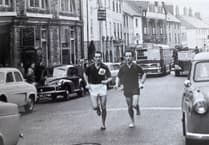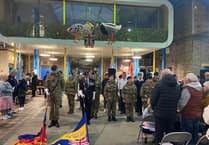THE story of a lost village hidden in thick woodland on the slopes of the Sugar Loaf has become something of a website wonder in the last week, but regular readers of the Abergavenny Chronicle will remember the village first hit the headlines way back in 1999 when reporter Liz Davies donned her walking boots and headed for the hills to join the small band of people given access to the site now known as Y Graig.
"At the time the people involved were very keen to keep its exact location a secret," said Liz, who is now the Chronicle’s editor.
"It was an amazing experience to be among the first visitors to the village in more than 100 years," she said.
To learn more about the village and its unique history we have trawled the Chronicle’s archives to find Liz’s original article which we have reprinted here...
THE lure of lost cultures from Atlantis to Brigadoon, has fascinated and been the topic of endless speculation for generations.
Now for the first time the interest has turned on the remains of a small village buried deep in dense woodland between Abergavenny and Brecon. Abandoned almost a century ago, historians are at a loss to explain why the village suddenly appeared, much less why it was equally as suddenly deserted.
Discovered during a survey of archaeological sites on land cared for by Forest Enterprise Wales the management of woodland owned by the nation, this lost village fits none of the traditionally accepted patterns for the development of settlement.
“The village seems to have been set up as a distinct event at the end of the 17th Century or at the beginning of the 18th,” said Mike Scott, Forest Enterprise Wales’ head ranger for the Llanymddyfri Forest District, who had agreed to give me a guided tour of the mysterious lost village.
Acclaimed as one of the most important finds of the survey, the village, which consists of around 25 ruined dwellings alongside two main trackways, has captured the imagination of the world’s media, appearing in newspapers and on television reports both at home and abroad.
Apart from a few selected camera crews and photographer and a small number of local people for whom the location of the site has been an ‘open secret for many years, few have visited the village since it was abandoned.
Provided with protection by the dense woodland which has surrounded it since the 1950s when the Forestry Commission first took over the land, the village is a puzzle to historians, who find it hard to explain why such fine houses could have been built by people who obviously had little in the way of money.
“It has been suggested that the land was given to a group of people by a local landowner and that they arrived as a community,” said Mike
“This was a time of great religious and social upheaval and maybe this had something to do with the creation of the village - possibly this was a religious settlement of some sort, although no evidence of a church of chapel has been found.
“Of course they could have been non-conformists meeting in a room in a house or even as one suggestion stages could have been a group of atheists,” he added.
After climbing the steep trackway to the village we came across the first of the ruined buildings - a small house and nearby storage area. It was here that Mike pointed out the bitter irony that the woodland which for many years has kept the site hidden and protected, was now in danger of destroying it.
Although sympathetically planted during the 1950s, the trees and scrub now threaten to topple taking walls and buildings with them.
“ I can see a few that have moved since I was last here a few months ago,” said Mike, who is now in the middle of a mammoth process of creating a management plan for the site.
“Some things can wait for a few years but some we are going to have to look at immediately if we want to halt he degeneration of the site,” he explained. As he spoke the gentle breeze set the trees swaying, emphasising his words and illustrating the urgency of the work.
Then began the long clamber down to one of the major areas of the village - the site of the bakery and dairy. With its large oven and skilfully built double chimney this communal building os one of the finest in the village.
“We haven’t found any evidence of other ovens so we are pretty sure that this was a communal bakery - the same applies to the butchery and the dairy and would seem to point to the village being run on the lines of a commune,”said Mike.
It is at the bakery that evidence of the skill of the builders of the village can be seen. With its dressed stone, arched window and mortared blocks, the buildings shows evidence of having been rough cast and white washed.
“This certainly took considerable skill to build,” said Mike, who explained that the site’s unusual nature makes it one of the rarest settlements sites in the country, if not the world.
“This is certainly not a site that was intended to be temporary,” said Mike, pointing out in evidence and rose bush and a gooseberry bush which sprouted further along the pathway.
Moving on we reached the building which is believed to be the village dairy, with its whitewashed interior and remained of inset large table-like slabs.
One of the most unusual and strangely attractive buildings in the whole site is an outside lavatory.
“The idea of an outside toilet is unheard of at this time, particularly one as beautifully designed and built as this one, with its stone box which would contain a bucket which could be removed from outside,” said Mike.
As carefully built as the houses, the toilet is designed to offer an unparalleled element of privacy, with a small angled corridor leading from the outside into the inner sanctum.
In similar vein to the privvy is the beautifully constructed pigsty at the other end of the village. With its corbel led roof, the sty, which remains watertight, is regarded as the finest in the country.
The only other one like this is at St Fagan’s and that’s reconstructed - this is untouched,” said Mike.
Setting off again with myself and photographer Malcolm Lewis in hot pursuit, Mike led us past more buildings in various states of repair and pointed out the remains of the terraces which were cut into the mountainside and used for the produce, which records say the villagers sold at market in Abergavenny.
“One reference say they grew grapes and figs which they carried to market in panniers, while others say they kept goats and sold milk and chess,” said Mike
In fact it it this reliance on produce to sell which some believe may have led to the downfall of the village and its abandonment.
It appears that in the late 18th Century, the local authority began to claim rent from the residents who refused to pay, saying they had been given the land.
After years of dispute it is suggested that the council sent in bailiffs to round up donkeys and goats - some 200-300 in total - and sell the animals in payment of the ‘debts’.
Unable to product their goats milk and cheese and robbed of the means of getting their other produce to market, the villagers had no option but to leave the community which they had created for themselves.
“Whatever happened the village was slowly deserted, with people moving away and taking all their belongings with them as witnesses by the complete absence of any finds at the site,” said Mike.
Whatever the cause, by the beginning of the 20th Century the site was deserted and by the 1950s when it was taken over by the Forestry Commission, it was all but forgotten.
“Much about the site is a mystery which we hope we will be able to unfold over the coming years,” said Mike.
“We do not know why it was build and by whom, how they lived and why it was abandoned. What we do know is that this is a rare opportunity to see a community that has been untouched or developed - it really is a piece of unique history.
“What is most important now is that we instigate a management plan to preserve the site and ensure that the woodland which for so long has offered it protection, does not now turn against it.”
“We’ve reached a critical point and have to move quickly to prevent more of the fragile part of the site being lost.”
It is because of the fragility of the site that Mike and Dr Caroline Earwood, archaeological consultant to Forest Enterprise Wales, are anxious to keep its exact location a secret.
“It’s not that there is anything valuable to be found here, as the villagers literally took everything with them when they left - it certainly wasn’t rushed,” said Mike.
“We simply want to avoid it attracting too many visitors because it people do start clambering all over the ruins, as you have to in order to reach them, they will be destroyed which would without a doubt be a great tragedy for this very special site,”
Moves are now afoot for the site to become a Scheduled Ancient Monument although Forest Enterprise Wales hopes to develop it in the future.
“It has been suggested that we should offer some interpretation of the site but I think for the immediate future the priority is for it to remain as it is but with a close eye kept upon it as it is a very special site. Hopefully as time goes on we will be able to learn more and more about its unique history,” said Mike.




